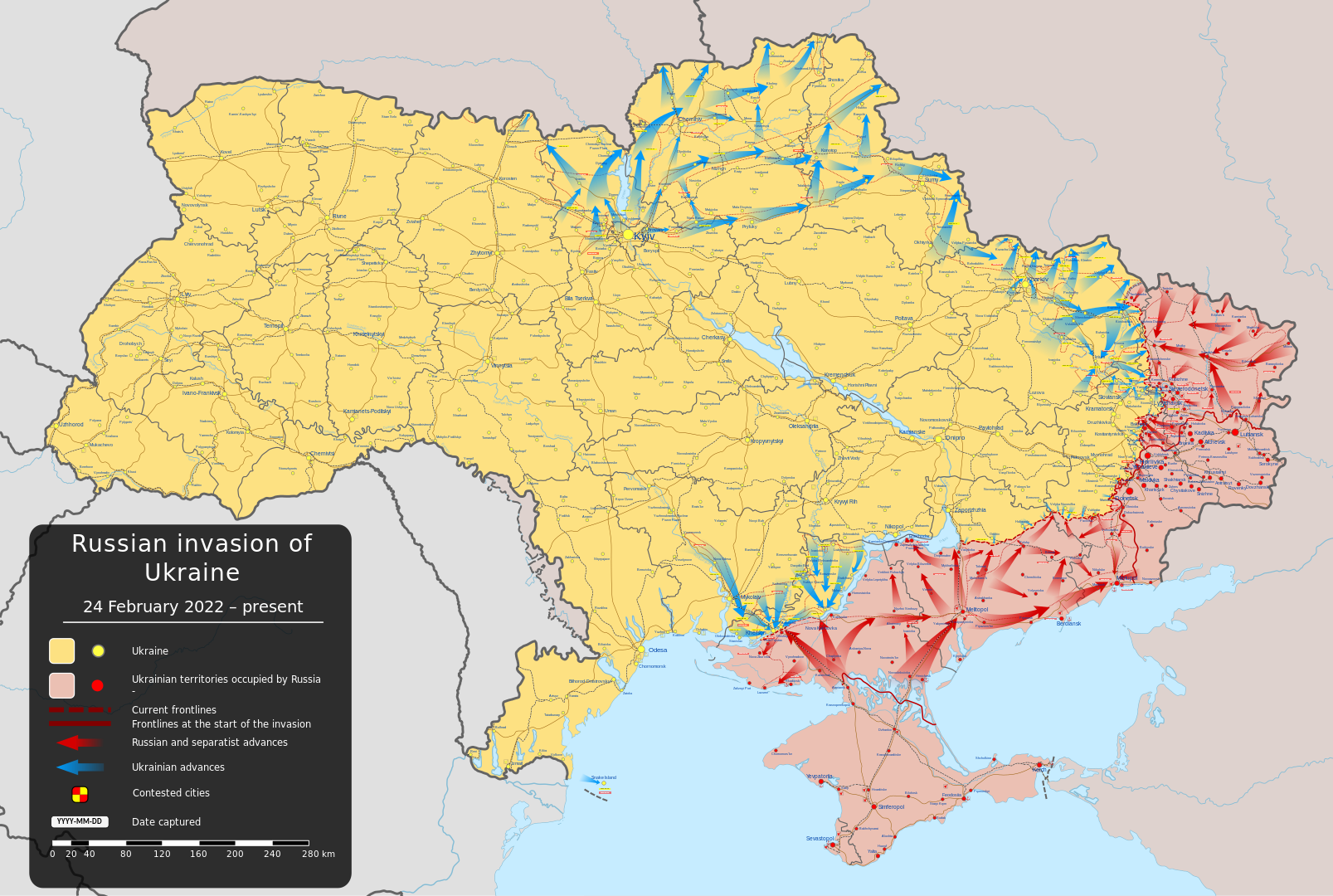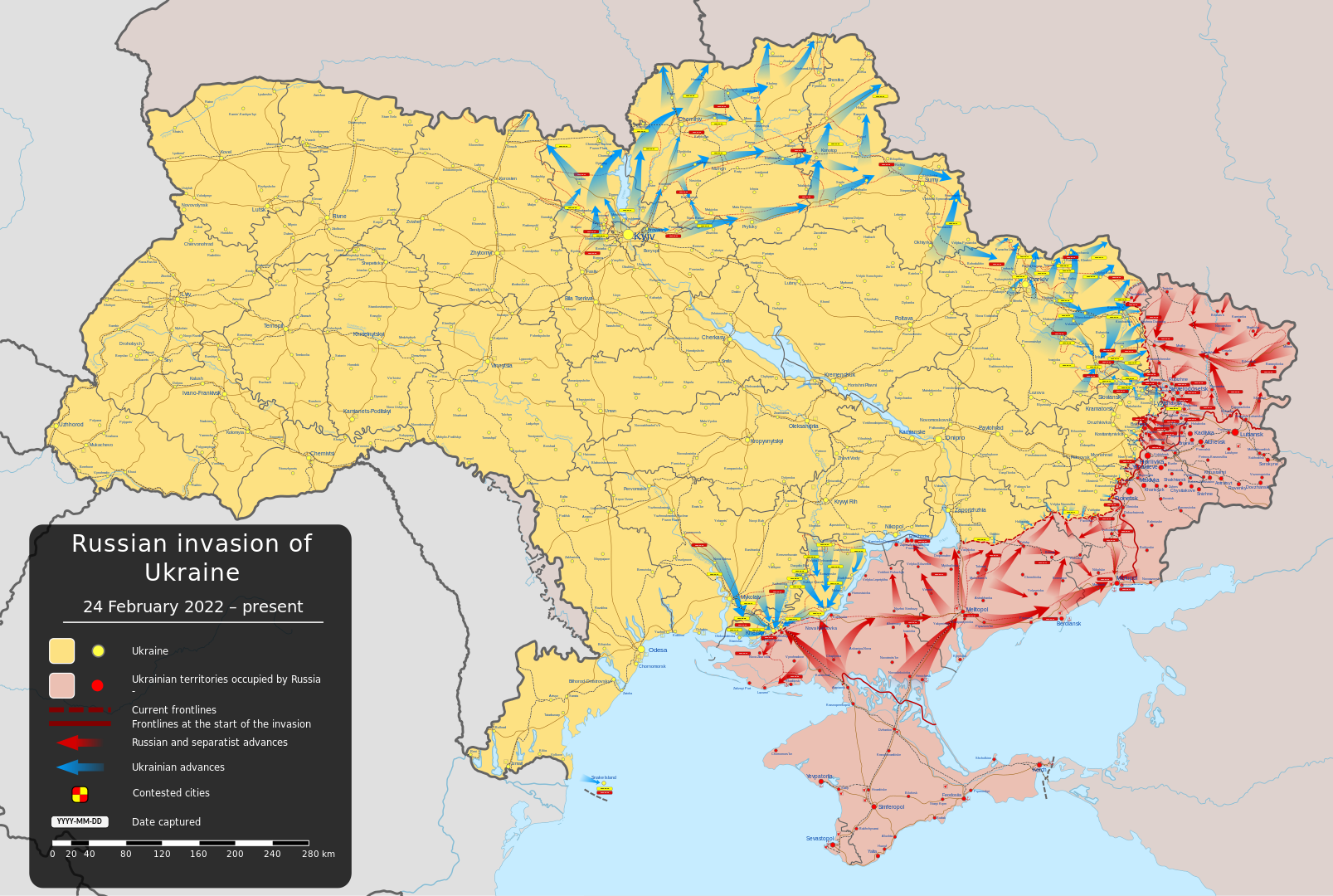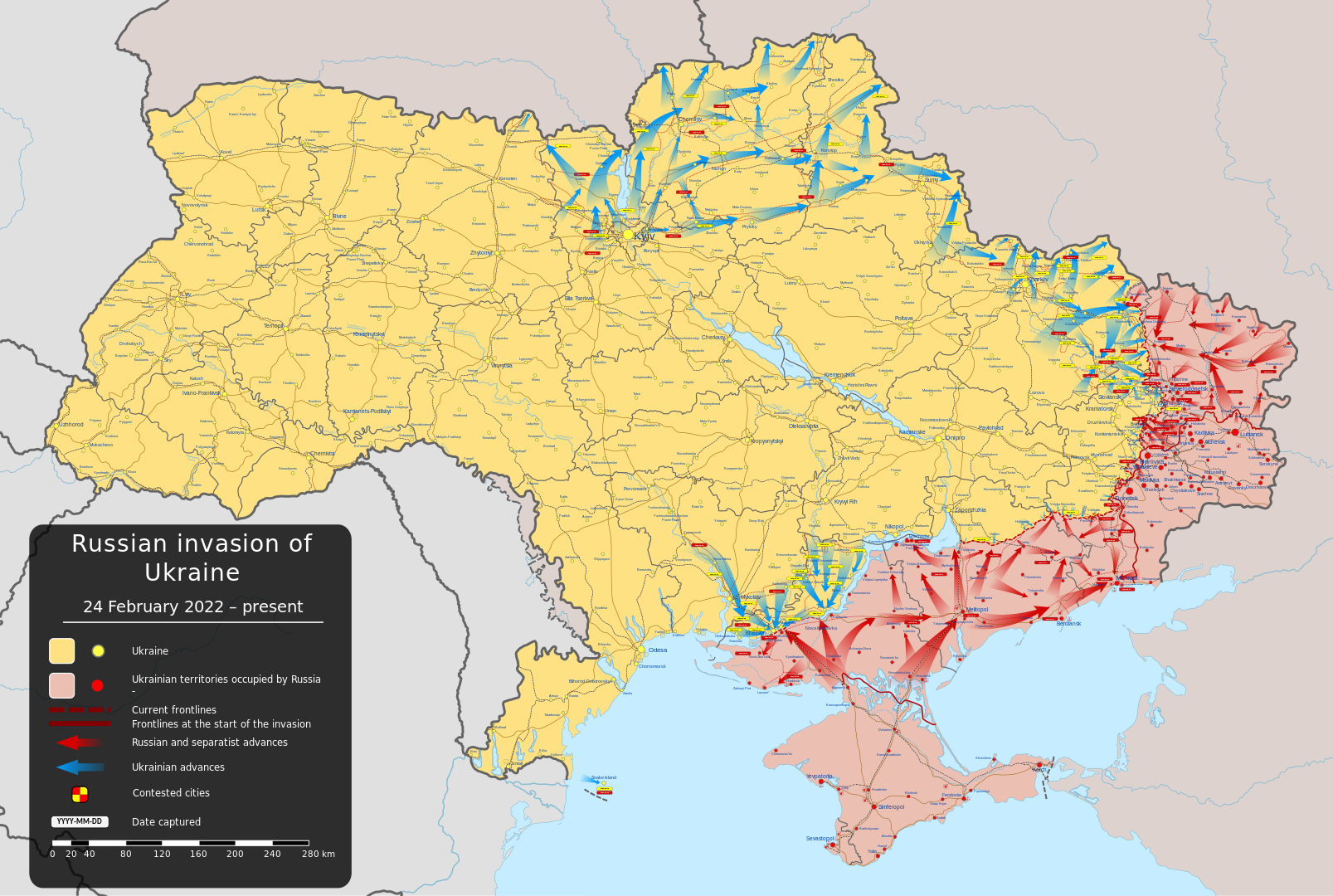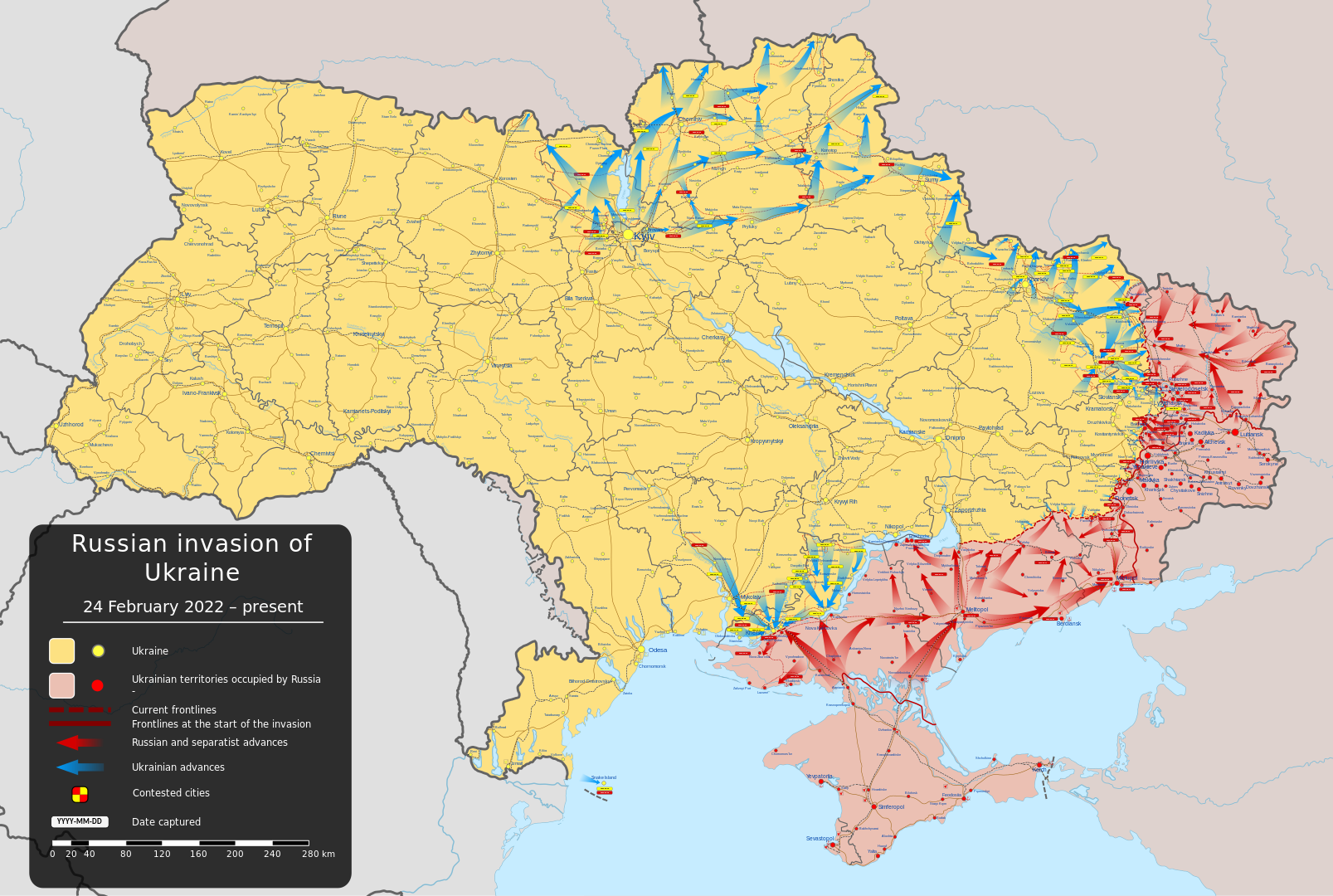
Spring Offensive: I am updating this posting twice a week, but there is really not a whole lot new to report. The Ukrainians are doing limited attacks in at least three locales in the south from west to east: 1) near Orikhiv, 2) near Huliaipole and 3) near Veyka Novosilka. They are also attacking around Bakhmut, both to the north and south of it. There is some action around Kreminna. Hesitant to repeat all the various reports out there.
It appears that Ukrainian offensive operations started on Monday, 5 June with a series of serious “shaping operations.” See: So has the Spring Offensive started? | Mystics & Statistics (dupuyinstitute.org). Some are saying the offensive started 4 June.
On 6 June Russia (probably) blew the Kakhovka dam. On 20 June Ukraine’s Interior Ministry reported that 21 people have died. Other people are reporting higher figures. This has temporarily shut down any operations in Kherson province.
On Thursday, 8 June, Russia released images showing a Ukrainian column moving up and being interdicted by artillery. They were supposedly near a village called Novopokrovka, probably the one in Zaporizhzhia Oblast to the NNE of Melitopol. As least one German Leopard 2A4 tank was destroyed along with 4 U.S. M-113s. See this video for a discussion: Update from Ukraine | The Counterattack Start is not good | Leopard-2 Convoy was Ambushed – YouTube. The unit was pretty compacted while it was travelling. I gather it was the 47th Mechanized Brigade, which was reported back in March to be armed with T-55S and Bradleys: The nine new brigades for the spring offensive – organization | Mystics & Statistics (dupuyinstitute.org).
On 10 June, Neskuchne (pop. 644 in 2016) was taken (or earlier). On 11 June, Blahodatne (pop. around 1,000) was taken by the Ukrainian 68th Jager Brigade. On 11 June Makarivka was taken. On 11 or 12 June Storozheve was taken by 35th Naval Infantry Bde. These are all small towns clustered to the northwest of Mariupol. A breakthrough here would effectively isolate Crimea and all points to the west. Lots of potential here, although it is still a fairly limited advance. Makarivka is 56 miles (90 kilometers) from Mariupol.
One twitter report on the action at Blahodatne said that 60 people from the 68th Jager Brigade attacked, and 4 were killed (see @armedMaidan for June 17). If this is true, this is a company-level attack by a brigade-sized force. I think this is fairly typical of what is happening across the front.
The 47th Mech Bde is one of the 9 new brigades raise for this offensive. The other two units listed above have been around since early in the war (April 2022 for the 68th) and from the beginning (in the case of the 35th Naval Infantry Bde). See: The nine new brigades for the spring offensive – organization | Mystics & Statistics (dupuyinstitute.org).
Overall, there is this advance which is making some progress to NW of Mariupol, there are two or three attacks going on to the west of there, all the way to the Kakhovka Reservoir, and there are one or two attacks going on around Bakhmut, the one attacking force sitting just to the NW of Bakhmut and perhaps holding the high ground there.
Some Ukrainian loss figures are coming in. The attack on the advancing tank company on 8 June resulted in at least one Leopard tank and 4 M-113 destroyed. It appears that four Leopards have been confirmed as lost overall along with 2 AMX-10RCs. A total of 16 U.S. Bradleys have been killed (see: Ukraine loses 16 US-made armored vehicles, group says, but still gains territory | CNN). This would indicate that the brigades involved include 47th Mech Bde (with 99 M-2 Bradleys) and the 37th Bde with 14 AMX-10s. It does appear that 2 of 9 new brigades slotted for this spring offensive have been committed to action. Some people are saying they have committed three new brigades (they are not named), see: Ukraine deploys 3 of 12 brigades in counteroffensive, main battle still ahead − Reuters (msn.com). Article also notes that “Muzyka believes that the counteroffensive initially progressed quite well, but progress seems to have stopped 5 or 6 days after the start of this significant phase. The analysist has no idea why it happened.
In general, it appears that the 47th Mechanized Brigade has had a battalion or two gutted (a mechanized infantry battalion has around 30 IFVs and they lost 16 Bradleys). There are no other significant losses reported.
Probably the most significant loss was four Leopard mine plow tanks were killed at the same time and place, along with an MRAP and a Bradley. Finland provided Ukraine with up to six of these modified tanks. Not sure what killed them but picture leaves one to suspect they were taken out by mines, which is kind of what they were supposed to sweeping. One wonders if this was an equipment shortfall.
On 12 June, Russian MG Sergei Goryachev, the COS 35th CAA, was reported killed by Russian bloggers. On 14 June Kadyrov (Chechen leader) reported that one of his commanders, Adam Delimkhanov, age 53, is missing and then later denied it. This guy: Adam Delimkhanov – Wikipedia.
I will put any changes/updates since my last post in italics. A link to a blow up of the map is here: Wikipedia map. It is dated 21 June. The map now has three updates for 2023, Soledar on 16 January, near Orkhiv on 9 June 2023 and near Velyka Novosilka on 11 June 2023. They are also showing Bakhmut in Russian hands.
Russia currently occupies five cities: Lysychansk (pop. 95,031), Severodonetsk (pop. 101,135), Mariupol (pop. 431,859), Berdyansk (pop. 107,928) and Melitopol (pop. 150,768). Kherson (pop. 283,649) was retaken by Ukraine on 11 November.
.
We have been looking at six major areas of operations. Only the Donbas appears to be active right now:
1. Kyiv (pop: 2,962,180): It appears that Kyiv is secure.
2. Odesa (pop: 1,015,826): Appears to be secure. The grain deal has been renewed for another 60 days. Since the start of these deals, the shipments have resulted in over thirty million tons of grain shipped by sea. As of 20 June, the amount of grain shipped from Ukrainian ports and across the Black Sea under this initiative was 32,062,044 metric tonnes carried in 987 ships according to posts on twitter by @exit266. There are 27 days left to the agreement.
Russia is claiming that they destroyed the Ukrainian 1,192-ton landing ship Yury Olefirenko, which is supposed to be Ukraine’s last warship. It was launched in 1970.
The Russian intelligence collection ship the Priazovye (3,470 tons full load) was attacked in the Black Sea by six sea-borne kamakaze drone. They were all intercepted and destroyed.
3. Kharkiv (pop: 1,433,886): Kharkiv looks to be secure. Still, it is near the Russian border, so this can change suddenly.
4. The Donetsk and Luhansk provinces (the Donbas): Complete write-up is available in this post: The Russo-Ukrainian War – Day 355 | Mystics & Statistics (dupuyinstitute.org). The Donetsk People’s Republic (DPR) is reporting as of 16 December that they had 4,133 soldiers killed and 17,379 wounded (4.20-to-1 wounded-to-killed ratio). This includes the 13 killed and 50 wounded reported from 01.01.22 to 02.25.22. For the period of 16 – 22 December (overlapping dates on 16 December) they report 43 killed, but do not report the wounded. Through the 16th, this is 108% casualties out of an estimated initial force of 20,000. Lugansk People’s Republic (LPR) is reported as of 5 April to have had 500-600 killed out of an estimated force of 14,000. This is 21% casualties, assuming a 4-to-1 killed ratio.
5. Mariupol (pop: 431,859): Complete write-up is available in this post: The Russo-Ukrainian War – Day 355 | Mystics & Statistics (dupuyinstitute.org). Google maps has updated its images of Mariupol to show the city as it is now (extensively shelled) vice how it used to look before the war.
Russia is putting 22 prisoners from Mariupol on trial. They are all members of the Azov Battalion, which Russia has designated a terrorist organization. Eight of the prisoners are woman, who are reported to have worked as cooks for the Azov Battalion. Two other prisoners who had been charged have been exchanged in prisoner exchanges.
Prisoner Exchanges: Russia has claimed that they captured 2,439 prisoners from the siege of Mariupol. Russian claimed on 30 June that they held 6,000 prisoners. Ukraine stated in early July that they had more than 7,000 missing. Now Ukraine is stating as of 30 December that Russian holds 3,400 prisoners and 15,000 Ukrainians are missing.
In 2022 there were 1,447 prisoners of war exchanged, 112 civilians and five foreigners. Of those, at least 427 were from Mariupol/Azovstal and up to 53 others were killed in captivity. Latest prisoner exchange on 8 January was for 50 prisoners. Another prisoner exchange on 4 February of 116. Some of these Ukrainian prisoners had been in captivity for almost a year. Latest prisoner exchange, on 16 February, was for 100 soldiers and one civilian for 101 Russian soldiers. 94 of them were defenders of Mariupol, including 63 soldiers from Azovstal. There was another prisoner exchange on 7 March with 130 Ukrainians exchanged for 90 Russians. This included 87 Mariupol defenders (71 from Azovstal). 35 of them were soldiers captured in Bakhmut and Soledar. Most of the Ukrainian and Russian prisoners were seriously injured.
The Ukrainian Omsbudsman has stated in late January that 800 severely wounded Ukrainians are held as POWs. He also stated that they hold 200 severely wounded Russians.
There was a prisoner exchange in early May of 42 soldiers and two civilians for what I assume was a similar number of Russians. On 7 May, Russia exchanged 45 defenders of Azovstal, including 10 officers for only just 3 pilots. I gather Russia is still holding thousands of more prisoners than Ukraine does.
Zelenskyy said on 6 June that they have recovered around 2,500 prisoners, including 370 civilians., The last count I had of Ukrainian captured was around 6,000.
There was yet another prisoner exchange on 11 June for 95 POWs.
6. Crimea & Kherson (pop: 283,649): Kherson is now back under Ukrainian control as of 11 November. Complete write-up is available in this post: The Russo-Ukrainian War – Day 355 | Mystics & Statistics (dupuyinstitute.org). Also see for updates: The Russo-Ukrainian War – Day 471 | Mystics & Statistics (dupuyinstitute.org).
.
Weather: Kharkiv at 6 PM: It is 79 degrees (26 Celsius) and mostly sunny. No rain is expected today or tomorrow, and then there is a chance of rain for the next seven days. Sunrise is at 4:25 and sunset is at 8:47, giving them more than sixteen hours of daytime to operate it.
Kherson is 79 degrees (26 Celsius) and mostly cloudy. Change of rain today and not rain expected for the next nine days.
Ukrainian Army Build-up: Complete write-up is available in this post: The Russo-Ukrainian War – Day 355 | Mystics & Statistics (dupuyinstitute.org). Updates are provided in this post: The Russo-Ukrainian War – Day 471 | Mystics & Statistics (dupuyinstitute.org).
Denmark and Netherlands are ordering up and buying another 14 Leopards for Ukraine. Belgium is offering up 40-50 more M-113s.
Russian Army Build-up: Complete write-up is available in this post: The Russo-Ukrainian War – Day 471 | Mystics & Statistics (dupuyinstitute.org).
Prigozhin reported that 32,000 prisoners who fought for Wagner have now returned home. So far, they have only committed 83 crimes since they left his employment.
Opposing forces: Complete write-up is available in this post: The Russo-Ukrainian War – Day 471 | Mystics & Statistics (dupuyinstitute.org).
Economics and the Home Fronts: The complete write-up is available in this post: The Russo-Ukrainian War – Day 380 | Mystics & Statistics (dupuyinstitute.org). Price of oil (Brent Crude) remains low at 76.81 as of 11:10 AM EST. Ruble remains low at 83.89 to the dollar.
On 6 May “right-wing” activist, Yevgeny Prilepin, was seriously injured near Nizhny Novgorod when his car was blown up. His bodyguard died. On 2 April, Vladlen Tartarsky, 40, a pro-war Russian blogger, was assassinated in St. Petersburg. The accidental assassin, who was also wounded, was Darya Trepova, 25. The previous war-related assassination was of Darya Dugina, 29, back on 20 August 2022. Not sure who was responsible for any of these three efforts.
There are still some political protests in Russia, with a female protester being arrested in Moscow and in Kazan. It is reported that over 100 protesters were arrested this last week: Russian police arrest more than 100 Navalny supporters, group says (msn.com).
Casualties: The commander-in-chief of the Ukrainian miliary, Valerii Zaluzhny, on 21 August stated that almost 9,000 Ukrainian military have died in the war. This is a lower estimate than most people have given (although we have leaned towards the lower estimates). Not sure if these figures included militia losses (like Azov Regiment). If Ukraine lost almost 9,000, then hard to believe the Russian losses are that much higher. On 1 December a presidential advisor stated that Ukraine has lost between 10,000 and 13,000 troops killed. On 17 March, the Ukranian Secretary of the National Security and Defence Council argued that total Ukrainian losses are less than 100,000 killed and wounded. As of 24 March 1,509 bodies have been returned to Ukraine.
The U.S. estimate is that Russian casualties are now at 220,000 (killed and wounded). The U.S. estimate provided on 9 November was “well over 100,000.” Did they really loose another 100,000 troops in the last five months? For 18 November BBC/Mediazona reported that 9,001 Russians had been killed based upon media accounts, obituaries, funeral notices, and so forth. Now their count is 18,023 as of 24 March. This is a doubling of their recorded count of people who have died. This is still considerably lower than the Ukrainian claims of 173,360 Russians killed as of 31 March (which would imply 693,440 to 866,800 total casualties, which does not mesh well with the reports of forces deployed). I do have some doubt about this suddenly increase in U.S. claims, see BBC/Mediazona Figures Over Time | Mystics & Statistics (dupuyinstitute.org) and Russian Losses over Time | Mystics & Statistics (dupuyinstitute.org). Needless to say, if I have doubts about the U.S. DOD estimates, then I don’t buy into the Ukrainian claims of Russian casualties, or the similarly high Russian claims of Ukrainian casualties.
The various versions of the briefing books did have Ukrainian and Russian casualty figures. They estimated that Ukrainian losses were 15,500 – 17,500 killed and 124,500 – 131,000 total casualties. This estimate may be a little “light,” but it is certainly within the ball park. They appear to be using a wounded-to-killed ratio of around 7.5-to-1 for this. This is kind of high. These figures may also include missing and captured (at least 6,000 were captured).
The Russian estimates are 35,500 – 43,000 killed and 189,500 – 223,000 total casualties. This may be on the high side. Ukraine is claiming over 180,000 Russians killed, which I think can be dismissed. BBC/Mediazona reports as of 7 April are counting 19,688 Russian killed by name. They appear to be using a wounded-to-killed ratio of around 5-to-1 for this.
Mediazona, through Dr. Olga Ivshina (BBC) @oivshina stated on 25 April that “…if we have 20,000 names we think the real toll may be around 40,000 KIA.” The exchange is here: The Dupuy Institute (TDI) on Twitter: “@oivshina Question: Do you mean that you suspect the actual count of dead is 1.5 times the count on your list, or is it 2.0 times the count on your list?” / Twitter.
These wounded-to-killed ratios open up a lot of questions. 1) why are they different for the Ukrainian vice the Russians, 2) I have been saying it is at least 4-to-1. They are using figures higher than that. What is that based upon?, and 3) some people on the “twittersphere” have criticized me for even using a 4-to-1 ratio and have used lower figures than that. Is it time for them to revise their estimating practices?
John Kirby, the NSC spokesman, said on 1 May that Russia has suffered 100,000 casualties since December, including over 20,000 killed (implying a 4-to-1 wounded-to-killed ratio). Half of the killed are from the Wagner Group.
The previous, more detailed older casualty write-up is available in this post: The Russo-Ukrainian War – Day 394 | Mystics & Statistics (dupuyinstitute.org).
The UN is reporting as of 18 June at least 9,083 civilians confirmed dead in the war. They reported 178 civilians killed for 1-31 March, 169 killed from 1-30 April, and 174 killed from 1-31 May.
The UN provided the following chart showing civilian losses by month:

More than 50,000 people have died in this conflict: 25,528 or more (Russian Army – Mediazona count as of 16 June) + 16,000 or more (Ukrainian Army – U.S. DOD estimate) + 9,083 (Civilians) + 4,176 (DPR in 2022) + 600 (LPR April 2022) = 55,387. It is probably in excess of 60,000 total deaths depending on Ukrainian and Russian military deaths and the real count of civilian losses. Suspect the BBC/Mediazona count is off (undercounted) by at least 50% and they say it is by a factor of two. The last figure from Ukraine of 13,000 was dated 1 December, so is also now probably off by at least 50%. Mediazona is now reporting that Donetsk and Lugansk losses were in excess of 8,000. If the Russian Army losses are indeed above 50,000 and Ukrainian Army losses are similarly high, then we could be looking at over 100,000 killed in this war.
An eighth American has been killed in Ukraine, Nick Maimer, 45, of Boise. He was a former Green Beret who was training Ukrainians. He was hit by artillery sometime in May.
Ammo: Complete write-up is available in this post: The Russo-Ukrainian War – Day 471 | Mystics & Statistics (dupuyinstitute.org).
Air Power: Previous discussion of air power is in the Day 443 post: The Russo-Ukrainian War – Day 443 | Mystics & Statistics (dupuyinstitute.org).
On 13 May, Russia lost 4 aircraft in one day, two Mi-8 helicopters, one Su-34 and one Su-35. This was their highly daily losses since the first month of the war. They were shot down just inside of the Russian territory, in Bryansk province.
Missile Defense: Discussion of previous missiles attack is in the Day 443 post: The Russo-Ukrainian War – Day 443 | Mystics & Statistics (dupuyinstitute.org). It was updated in this post: The Russo-Ukrainian War – Day 471 | Mystics & Statistics (dupuyinstitute.org).
End of the War: Looks like this war will be continuing onto until at least fall of 2023. Complete write-up of this section is available in this post: The Russo-Ukrainian War – Day 380 | Mystics & Statistics (dupuyinstitute.org).
Atrocities: Complete write-up is available in this post: The Russo-Ukrainian War – Day 355 | Mystics & Statistics (dupuyinstitute.org). Updates are provided in this post: The Russo-Ukrainian War – Day 471 | Mystics & Statistics (dupuyinstitute.org).
Ukrainian reforms: Complete write-up is available in this post: The Russo-Ukrainian War – Day 355 | Mystics & Statistics (dupuyinstitute.org). The Ukranian defense minister appears to be staying.
Other Issues:
U.S. Support for Ukraine: Write-up on U.S. support for Ukraine is in the Day 443 post here: The Russo-Ukrainian War – Day 443 | Mystics & Statistics (dupuyinstitute.org). It is going to be a long campaign season until November 2024, so certainly we will revisit this issue at some point. The total amount of support committed by the U.S. to Ukraine is $133 Billion.
The U.S. resolved its “debt crisis” with the debt limit being suspended until 2025. Defense spending is capped at $886 billion, or 3.5% increase over the previous year. This matches the current administrations budget request. Spending on defense is limited to a 1% growth in 2025, or up to $895 billion.
A few dates to keep in mind for the American political campaigns: 1) trial date for Donald Trump on classified documents is set at 14 August 2023, 2) the first (of two?) Republican primary debates is set for 23 August, 3) the Iowa caucuses will be in mid-January 2024 (date has not been set yet), 4) the New Hampshire primary is scheduled for 13 February 2024, 5) 24 February is SC primary, then MI, 6) on 5 March 14 states will hold their primaries and between 9 – 23 March another 15 states/territories will hold their primaries. The Republican nominee could be decided by then, 7) 25 March is the trial date for Donald Trump’s Stormy Daniel’s related case, 8) last Republican primary is 4 June 2024. I actually do think this is war related news as the currently the two leading Republican presidential candidates do not support Ukraine.
Also, see the Day 443 posts for previous reports on the EU, NATO, Georgia and Nagorno-Karabakh. On 20 May, Lavrov’s daughter (Lavrov is the foreign minister of Russia) attended a wedding in Georgia. There were protests by the Georgians, with her car egged. She was forced to leave because of the public reaction.
Belarus: Belarus is back in the news as its dictator, Lukashenko, is ill. Also, Belarus has signed an agreement on 25 May with Russia about basing tactical nuclear weapons there, with some sources claiming they have been deployed there. I still doubt that they will join the war. Belarus has 60,000 troops and now they are trying to recruit another 20,000. This is from a country that the government was almost overthrown two years ago by popular acclaim. Ukraine has an 891-kilometer border (554 miles) with Belarus, so Ukraine must maintain some forces there. Reports are now saying that only about 4,000 Russian troops are in Belarus, and no nuclear forces are there.
On 16 June Putin did announce that tactical nuclear weapons have been deployed to Belarus. One unconfirmed (and unconfirmable) estimate is that it is 10-12 68 KT weapons. On 20 June the head of Ukrainian intelligence said that no nuclear weapons have yet been moved to Belarus.
NATO: As of 4 April, Finland is a member of NATO. Sweden is still awaiting approval from Hungary and Turkey. See Day 443 for more info. Erdogan, age 69, won the election on 28 May with 52% of the vote. Voter turn-out was 84%. Next election is in five years. We shall see if he is now willing to let Sweden into NATO.
Sections on Kazakhstan, European Support, Iran and Miscellaneous were last reported in the blog post for day 408 here: The Russo-Ukrainian War – Day 408 | Mystics & Statistics (dupuyinstitute.org). They have been removed from this post.





 USS America in Vestfjord clearly showing how the mountains would block the line of sight of missile-carrying bombers until they were very close to the target. (USNI Proceedings)
USS America in Vestfjord clearly showing how the mountains would block the line of sight of missile-carrying bombers until they were very close to the target. (USNI Proceedings) Yellow: SNA ASCM-carrying bombers fly from bases on and near the Kola, around the North Cape and down the coast of Norway. Large purple circle: Kh-22 300nm launch line. Small purple circle: Kh-22 67nm launch line (reduced by the radar shadow in Vestfjord). Blue: USN F-14 fleet defense fighters push north to intercept the SNA before they can get radar line-of-sight to the CVBG. Red: VVS Bomber Aviation Division uses the mountains to screen its attack on the CVBG.
Yellow: SNA ASCM-carrying bombers fly from bases on and near the Kola, around the North Cape and down the coast of Norway. Large purple circle: Kh-22 300nm launch line. Small purple circle: Kh-22 67nm launch line (reduced by the radar shadow in Vestfjord). Blue: USN F-14 fleet defense fighters push north to intercept the SNA before they can get radar line-of-sight to the CVBG. Red: VVS Bomber Aviation Division uses the mountains to screen its attack on the CVBG.
